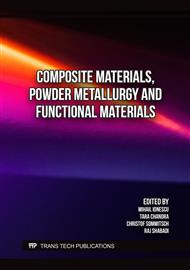[1]
P. Duwez, S.C.H. Lin, Amorphous ferromagnetic phase in iron-carbon-phosphorous alloys, J. Appl. Phys. 38 (1967) 4096-4097.
DOI: 10.1063/1.1709084
Google Scholar
[2]
A. Inoue, A. Makino, T. Mizushima, Ferromagnetic bulk glassy alloys, J. Magn. Magn. Mater. 215-216 (2000) 246-252.
DOI: 10.1016/s0304-8853(00)00127-x
Google Scholar
[3]
X.S. Li, J. Zhou, L.Q. Shen, B.A. Sun, H.Y. Bai, W.H. Wang, Exceptionally high saturation magnetic flux density and ultralow coercivity via an amorphous-nanocrystalline transitional microstructure in an FeCo-based alloy, Adv. Mater. 34 (2022) 2205863.
DOI: 10.1002/adma.202205863
Google Scholar
[4]
H.X. Li, Z.C. Lu, S.L. Wang, Y. Wu, Z.P. Lu, Fe-based bulk metallic glasses: glass formation, fabrication, properties and applications, Prog. Mater. Sci. 103 (2019) 235-318.
DOI: 10.1016/j.pmatsci.2019.01.003
Google Scholar
[5]
A. Inoue, T. Zhang, H. Koshiba, A. Makino, , A. Makino, T. Masumoto, High saturation magnetization and soft magnetic-properties of bcc Fe-Zr-B alloys with ultrafine grain-structure, New bulk amorphous Fe-(Co,Ni)-M-B (M=Zr, Hf, Nb, Ta, Mo, W) alloys with good soft magnetic properties, J. Appl. Phys. 83 (1998) 6326-6328.
DOI: 10.1063/1.367811
Google Scholar
[6]
S. Ikeda, K. Miura, H. Yamamoto, K. Mizunuma, H.D. Gan, M. Endo, S. Kanai, J. Hayakawa, F. Matsukura, H. Ohno, A perpendicular-anisotropy CoFeB-MgO magnetic tunnel junction, Nat. Mater. 9 (2010) 721-724.
DOI: 10.1038/nmat2804
Google Scholar
[7]
F. Magnus, M.E. Brooks-Bartlett, R. Moubah, R.A. Procter, G. Andersson, T.P.A. Hase, S.T. Banks, B. Hjorvarsson, Long-range magnetic interactions and proximity effects in an amorphous exchange-spring magnet, Nat. Commun. 7 (2016) 11931.
DOI: 10.1038/ncomms11931
Google Scholar
[8]
W.J. Liu, H.X. Zhang, J.A. Shi, Z.C. Wang, C. Song, X.R. Wang, S.Y. Lu, X.J. Zhou, L. Gu, D.V. Louzguine-Luzgin, M.W. Chen, K.F. Yao, N. Chen, A room-temperature magnetic semiconductor from a ferromagnetic metallic glass, Nat. Commun. 7, 13497 (2016).
DOI: 10.1038/ncomms13497
Google Scholar
[9]
N. Chen, K.X. Fang, H.X. Zhang, Y.Q. Zhang, W.J. Liu, K.F. Yao, Z.J. Zhang, Amorphous magnetic semiconductors with Curie temperatures above room temperature, J. Semicond. 40, 081510 (2019).
DOI: 10.1088/1674-4926/40/8/081510
Google Scholar
[10]
Y.Z. Jiao, D.V. Louzguine-Luzgin, K.F. Yao, Z.J. Zhang, N. Chen, A room-temperature magnetic semiconductor from a Co-Fe-Nb-B metallic glass, Sci. China Phys. Mech. Astro. 66 (2023) 246111.
DOI: 10.1007/s11433-022-2042-x
Google Scholar
[11]
H. Ohno, Making nonmagnetic semiconductors magnetic, Science 281 (1998) 951-956.
Google Scholar
[12]
H. Ohno, D. Chiba, F. Matsukura, T. Omiya, E. Abe, T. Dietl, Y. Ohno, K. Otani, Electric-field control of ferromagnetism, Nature 408 (2000) 944–946.
DOI: 10.1038/35050040
Google Scholar
[13]
K. Ando, Seeking room-temperature ferromagnetic semiconductors, Science 312 (2006) 1883-1885.
DOI: 10.1126/science.1125461
Google Scholar
[14]
T. Dietl, H. Ohno, F. Matsukura, J. Cibert, D. Ferrand, Zener model description of ferromagnetism in zinc-blende magnetic semiconductors, Science 287 (2000) 1019-1022.
DOI: 10.1126/science.287.5455.1019
Google Scholar
[15]
A.H. MacDonald, P. Schiffer, N. Samarth, Ferromagnetic semiconductors: moving beyond (Ga, Mn)As, Nat. Mater. 4 (2005) 195-202.
DOI: 10.1038/nmat1325
Google Scholar
[16]
Y. Matsumoto, M. Murakami, T. Shono, T. Hasegawa, T. Fukumura, M. Kawasaki, P. Ahmet, T. Chikyow, S. Koshihara, H. Koinuma, Room-temperature ferromagnetism in transparent transition metal-doped titanium dioxide, Science 291 (2001) 854-856.
DOI: 10.1126/science.1056186
Google Scholar
[17]
H.M. Wang, S. Sun, J.T. Lu, J.Y. Xu, X.W. Lv, Y. Peng, X. Zhang, Y. Wang, G. Xiang, High Curie temperature ferromagnetism and high hole mobility in tensile strained Mn-Doped SiGe thin films, Adv. Funct. Mater. 30 (2020) 2002513.
DOI: 10.1002/adfm.202002513
Google Scholar
[18]
L. Chen, X. Yang, F.H. Yang, J.H. Zhao, J. Misuraca, P. Xiong, S. von Molnar, Enhancing the Curie Temperature of Ferromagnetic Semiconductor (Ga,Mn)As to 200 K via Nanostructure Engineering, Nano Lett. 11 (2011) 2584–2589.
DOI: 10.1021/nl201187m
Google Scholar
[19]
Y.Q. Zhang, S.F. Zhao, C. Song, W.J. Liu, K.F. Yao, N. Chen, Electric-field control of ferromagnetism in a Co-Fe-Ta-B amorphous alloy, Mater. Design 143 (2018) 65-71.
DOI: 10.1016/j.matdes.2018.01.046
Google Scholar
[20]
S. Narushima, H. Mizoguchi, K. Shimizu, K. Ueda, H. Ohta, M. Hirano, T. Kamiya, H. Hosono, A p-type amorphous oxide semiconductor and room temperature fabrication of amorphous oxide p-n heterojunction diodes, Adv. Mater. 15 (2003) 1409-1413.
DOI: 10.1002/adma.200304947
Google Scholar
[21]
W.F. Gale, T.C. Totemeier, Smithells Metals Reference Book, Elsevier, Butterworth-Heinemann, Burlington, 2004, pp.259-261.
Google Scholar
[22]
A.J. Gubanov, Quasi-classical theory of amorphous ferromagnetics, Soviet Phys.-Solid State 2 (1960) 468-471.
Google Scholar
[23]
K.A. Stewart, V. Gouliouk, D.A. Keszler, J.F. Wager, Sputtered boron indium oxide thin-film transistors, Solid State Electron. 137 (2017) 80-84.
DOI: 10.1016/j.sse.2017.08.004
Google Scholar
[24]
J. Robertson, Band offsets of wide-band-gap oxides and implications for future electronic devices, J. Vac. Sci. Technol. B 18 (2000) 1785-1791.
DOI: 10.1116/1.591472
Google Scholar
[25]
T. Onozato, T. Katase, A. Yamamoto, S. Katayama, K. Matsushima, N. Itagaki, H. Yoshida, H. Ohta, Optoelectronic properties of valence-state controlled amorphous niobium oxide, J. Phys: Condens. Matter. 28 (2016) 255001.
DOI: 10.1088/0953-8984/28/25/255001
Google Scholar
[26]
D. Music, Y.−T. Chen, P. Bliem, R.W. Geyer, Amorphous – crystalline transition in thermoelectric NbO2, J. Phys. D: Appl. Phys. 48 (2015) 275301.
DOI: 10.1088/0022-3727/48/27/275301
Google Scholar



